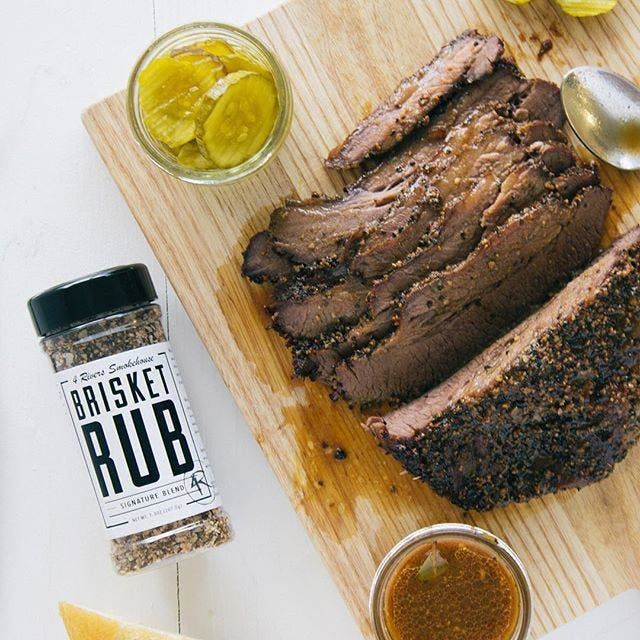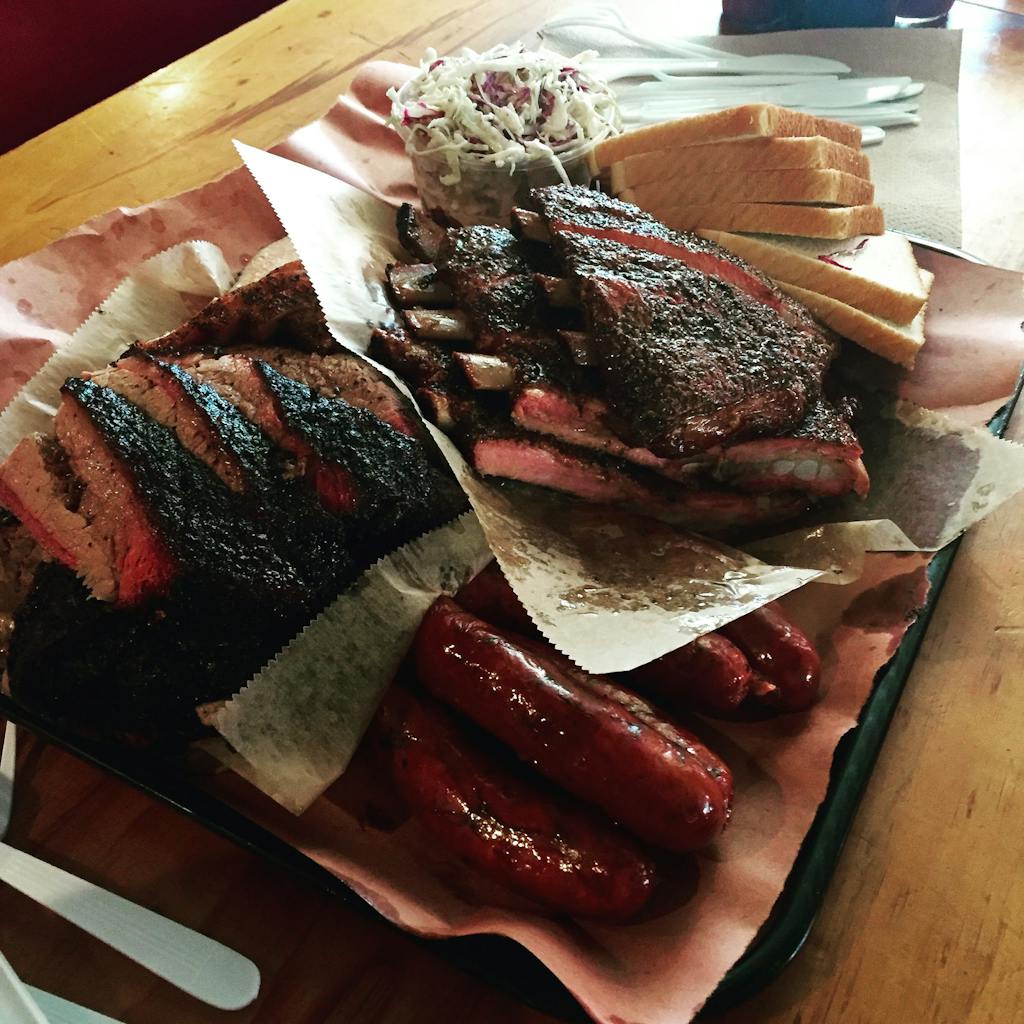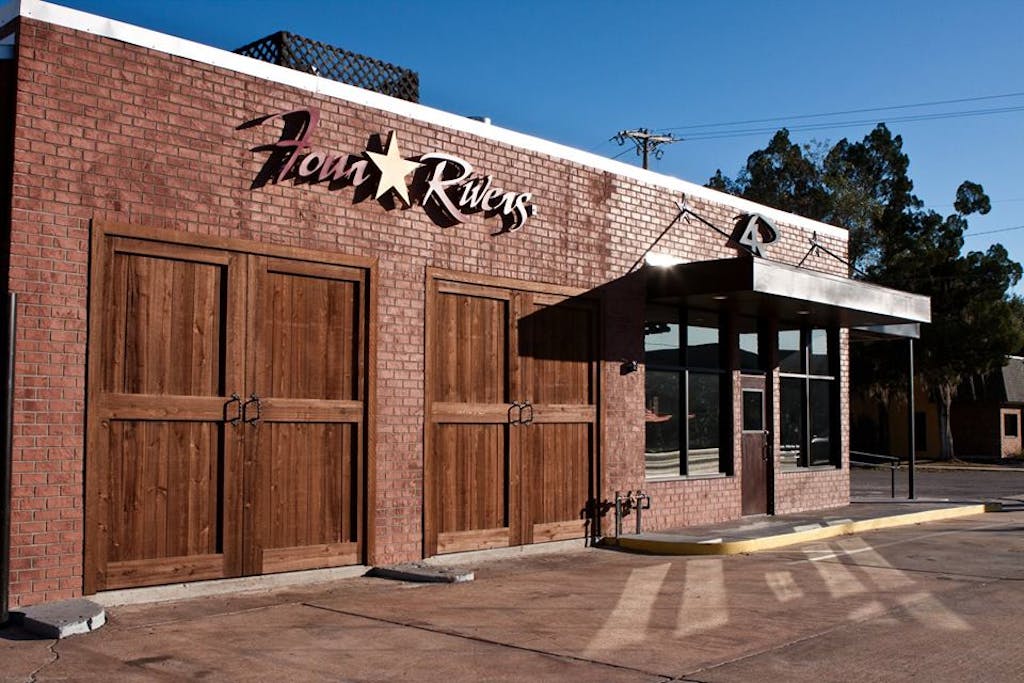 Owner/Pitmaster: 4 Rivers Smokehouse; Opened 2009
Owner/Pitmaster: 4 Rivers Smokehouse; Opened 2009
Age: 49
Smoker: Gas-fired rotisserie
Wood: Hickory
Sitting with a 2003 copy of the Texas Monthly Top 50, John Rivers occupied a table inside Rusty Taco in Dallas waiting for me. His travel schedule didn’t allow for a barbecue lunch, so bacon, eggs, cheese, and avocado on a tortilla became the best option. Austin was his afternoon destination where he would meet his team from 4 Rivers Smokehouse based in Winter Park, Florida. They had two days of Texas barbecue exploration ahead of them.
Rivers started his career in healthcare, then switched his focus away from the corporate world to his garage smokehouse. Cooking weekly for fundraisers got him his chops, but he wasn’t sure he had made it until he could impress his in-laws in Texas with his smoked brisket. Once he got that approval, a restaurant was the next logical step.
The restaurant opened in a converted auto repair shop in 2009. My only visit was back in 2011 where I found impressive smoked brisket, and plenty more than Texas classics on the menu. This was the first passable brisket I’d encountered in Florida. With nine locations and growing, Rivers might now be credited with bringing brisket awareness to the rest of the Sunshine State.
Daniel Vaughn: You make Texas-style barbecue, so where did you grow up?
John Rivers: Jacksonville, Florida. I was there until college, then moved here to Dallas after college. That was ’89 and ’90.
DV: What barbecue do you remember eating around here in those days?
JR: Back then it was Sonny Bryan’s and County Line. None of the little places were around then. When I was in Dallas, I like the barbecue because it was different from where I grew up, but when I went down into the Austin area and into Central Texas, that’s when I just lit up. I’d never seen brisket served like that on the trays. Watching the guys cut it, I thought that was the coolest thing.
DV: Were you taking those trips to Central Texas while living in Dallas?
JR: Oh yes. Back then, my to-be wife, who is from Texas, had family split between Austin and Victoria. We’d drive down and eat on the way.
DV: Growing up in Florida, was barbecue something that you ate often?
JR: Oh yeah. There was an emotional connection to barbecue. I can’t say that it was great barbecue. There was a place called Bono’s in Jacksonville. My grandpa and I would go there every Wednesday until about two weeks before he passed. It’s a different type of barbecue. It’s a big open pit and the guys there are turning it with a fork constantly right there in front of you. He just loved to watch it, and I did to. That was our style of barbecue.
DV: What was on the menu?
JR: Everything pork. Beef barbecue in Florida in the ‘80’s was a big roast that was overcooked. I think that’s why so many people in the South don’t like beef barbecue. They’ve never had the good stuff. Their reference point is cold, dry beef.
DV: Do you remember when you had brisket for the first time?
JR: Oh yes. It was Thanksgiving Day in 1990. We went down to my wife’s cousin’s house in Sugarland. On the table was a beautiful smoked turkey and a big chunk of this black stuff covered with pepper and salt. I was curious as they were cutting it, and I made the mistake. Of saying “What is that?” That’s when all hell broke loose. I was in healthcare back then, but I loved to cook and barbecue was a great affinity. These guys were just relentless that I’d never had brisket before, and rightly so. My testosterone got the best of me, and I remember saying “I’m going to learn how to make brisket, and I’m going to make it better than anybody here.” At the time, I didn’t even own a smoker. I got a little Weber. I went through about twenty of them until I started welding them myself. The first brisket I did was with a few friends who came over for football. I did a four pound flat that I smoked for about four hours. It was an oversized hockey puck. We were all a combination of drunk and mad and we threw it up against the wall, and ordered pizzas for the party.

DV: Do you remember now if that brisket in Sugarland was good?
JR: Yes, and it was my first taste of it. It was the beginning of what has become a fascination. I traveled all over the country when I was in healthcare. I was collecting a lot of styles and learning new techniques. The thing about a lot of pitmasters is that they like talking about what they do. There was a welcoming sense to it. I’d go back home and watch videos and I was a copious reader of cookbooks. Texas was my target. I fell in love with Smitty’s. I wanted it to be as good as I’d had down in Lockhart. I just kept pushing, and it took me eighteen years of everything from injections to brines to finally get to where I thought it was as good as I’d had before. The very next week I made one and put it in one of those H-E-B cooler bags. I flew it down to Sugarland and made my cousins eat it.
DV: How did they like it?
JR: They order it now for every Christmas.
DV: So for Christmas, your family who made fun of you about brisket, is now getting a 4 Rivers brisket for Christmas every year. That’s some irony for you. In your travels were there some other places that made an impression on you?
JR: I love Kansas City style. The place that was called Oklahoma Joe’s was great. The problem is that when you start honing in that much you get very particular. Your range starts to narrow for what you consider to be great brisket. I’m excited now because I’m going down to Austin today. Tomorrow we’re trying out Franklin for the first time.

DV: You were in healthcare. Was the brisket that you brought down to Sugarland the turning point where you decided to go into the barbecue business?
JR: That was in 2008, and we opened the restaurant (in Winter Park, Florida) in 2009. We sold our healthcare company. I retired from it and we started running or barbecue ministry out of my garage. That’s really how this whole thing started. There was this little girl who had cancer and needed some help. Her parents wouldn’t take money, but they would allow me to run a barbecue fundraiser for them at their church. This was in 2005. That was the first time I took my passion of smoking meat and used it to help people. I did that for four years. I would go to work through the week, and on Friday night I’d light the smoker. We’d have the fundraisers on Saturday, and I never did it for money. I did it to help people. After I retired, I was doing even more ministry work. It got to be so much. The last year out of my garage, we estimate that we served 50,000 people. I built this house to retire in, and the third stall of the garage was built as a smokehouse. Then it got so ridiculous, my wife said “you’re not doing this in the house anymore.” In an effort to invest back in to the community, I took over a dilapidated building that used to be a Just Brakes. We went into it so naively. They told us it would be $188,000 and three or four months. I didn’t know squat about opening a restaurant. Six months into it I had a half million into it and my contractor got into a cash crunch and was gone. This was 2009. We were in the middle of a recession. All the money I’d gotten from retirement, I put into mutual funds. They were way down. We’d just built a new house that was losing value. Long story short, Monica and I were down to sixty days worth of cash.
DV: Basically, you started this endeavor with plenty to fall back on, but once you got near the finish line it was almost gone.
JR: Yes. Literally, in the next two weeks a few good people stepped in. One was a contractor who saw the almost finished place and thought I needed help. He got me the [certificate of occupancy] 59 days later. Another was Dan Cathy, the CEO of Chick-fil-A. He had my brisket from some friends who had gotten it at a charity event. They took it back to Atlanta, they were all running late for a dinner party, so they threw it in the microwave and that’s where Dan and Rhonda had it for the first time.
DV: Maybe not exactly how you’d have preferred to serve it.
JR: Hey, it did the trick. He left me a voicemail a few days later. They never helped financially, but he gave me confidence. I asked what we should expect for daily revenue, and he told me $2000 a day would be really good. On October 29th 2009, we opened the doors. We were down to one day of cash. Every piece of equipment was used, we had no money to advertise or promote. All we could do was unlock the door. That’s when it started happening. I had friends coming in, then people starting lining up, some of them we didn’t know who they were. We had only twelve employees, and two of them were my wife and me. That day we did $3500 in sales. It’s the lowest day we’ve ever had in our history. We have 1400 employees now, and we still run it as a ministry. A huge part of our revenue goes back into the community. If you take care of the people around you, they’re going to come in. As long as it’s good, they’ll continue to support you.

DV: That all started in Winter Park, but you have multiple locations now.
JR: They’re all in Florida right now. We’re getting ready to make an entrance into South Florida. I’m anxious now to start crossing state lines into Georgia, and maybe Alabama.
DV: When you first opened, were you worried about centering your menu around brisket in Florida?
JR: I was excited to educate the market about what good smoked beef is. I was told that it wasn’t going to work, serving beef on trays lined with paper. Now it’s our number one seller.
DV: What was on the menu when you opened?
JR: Brisket was the first thing people saw. Some thought it was a pork roast. We would just give them a taste. My favorite customers were Texans. They always warned me that you can’t make good brisket outside Texas. The best part is that they would always come back in and thank me. We also make kolaches. I had my target. It was Prasek’s in El Campo. I loved their sausage, and I would buy dozens and fly back with them. I tried to replicate it, and I just couldn’t so I called grandma in Hallettsville. She knew the kolache queen in town, Lilly. Lilly was 89. She didn’t have a recipe, so we got on a plane to go make kolaches with her. She was quiet, but asked for some wine while she was making it. All these stories were coming out, but she wasn’t telling us what she was putting into it. I told my guys they needed to keep track of it all. We got enough. We went back and started making kolaches with Prasek’s sausage.
DV: 4 Rivers has done a lot to spread the word of Texas barbecue in Florida. It sounds like before you opened that there wasn’t much to choose from.
JR: One of the most fulfilling things is to see people come in and eat it for the first time. Then they tell their friends about how great brisket is. There really isn’t a barbecue style in Florida, so it’s great to see people embrace brisket. It’s amazing now to see how many other restaurants have started serving it.
DV: How much of it do you serve?
JR: We’ll be right at two million pounds this year. We use CAB, and every brisket is aged for thirty days. We’re closed on Sundays, so the pits only stop on Saturday night to get cleaned out.
DV: You’re headed down to Central Texas. Is there a part of you that worries about finding brisket that’s better than yours?
JR: Gosh no. I would love that challenge. I get fired up about that. I’m bringing my team over here because they need to know what it tastes like from a true Texas smokehouse. If they don’t know that, where’s the authenticity? I want them to feel it and taste and know what the experience is like. This is important for me to keep our integrity.
DV: Are you still having fun doing this?
JR: I am. The ministry has driven us, and so have people telling me I can’t do this in the middle of pulled pork region – serving brisket with no plates.
DV: You seem to have done it successfully.
JR: What’s really neat is that every new city we go to, we start he whole process over. In the beginning to watch people light up after that first bite they have, I get excited about that.







